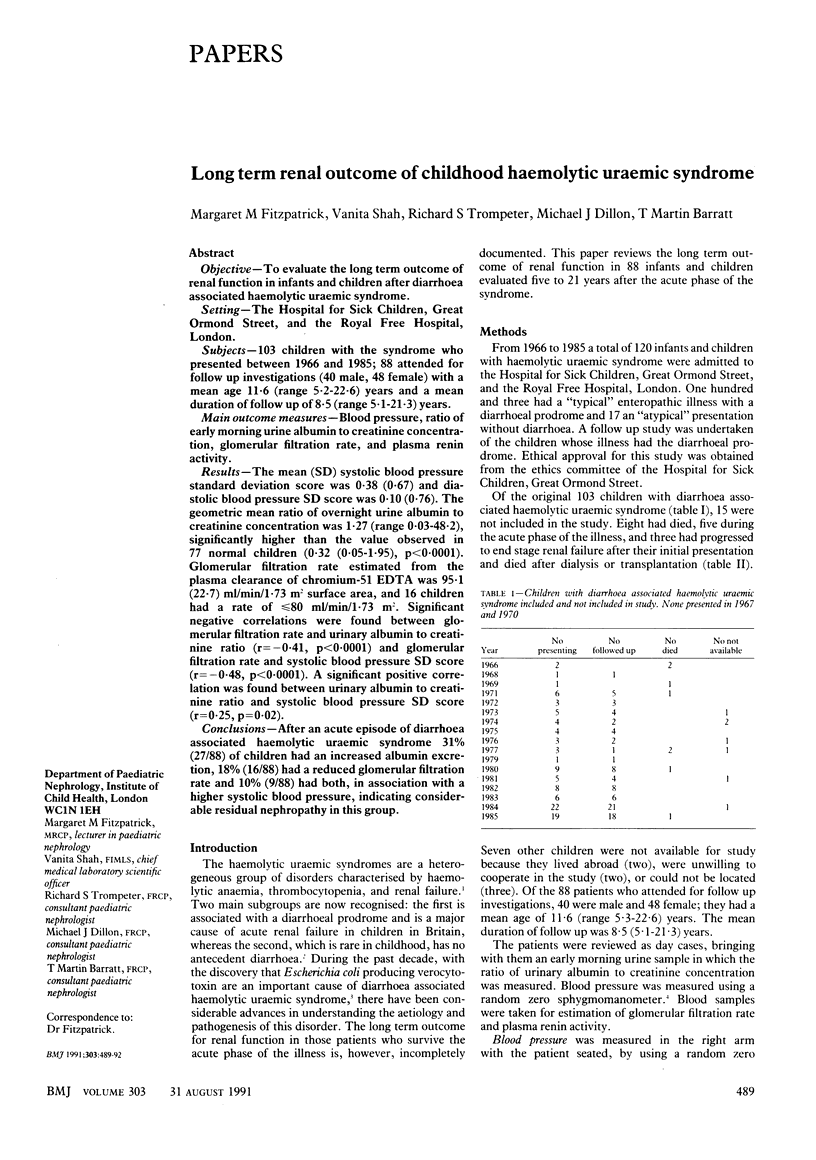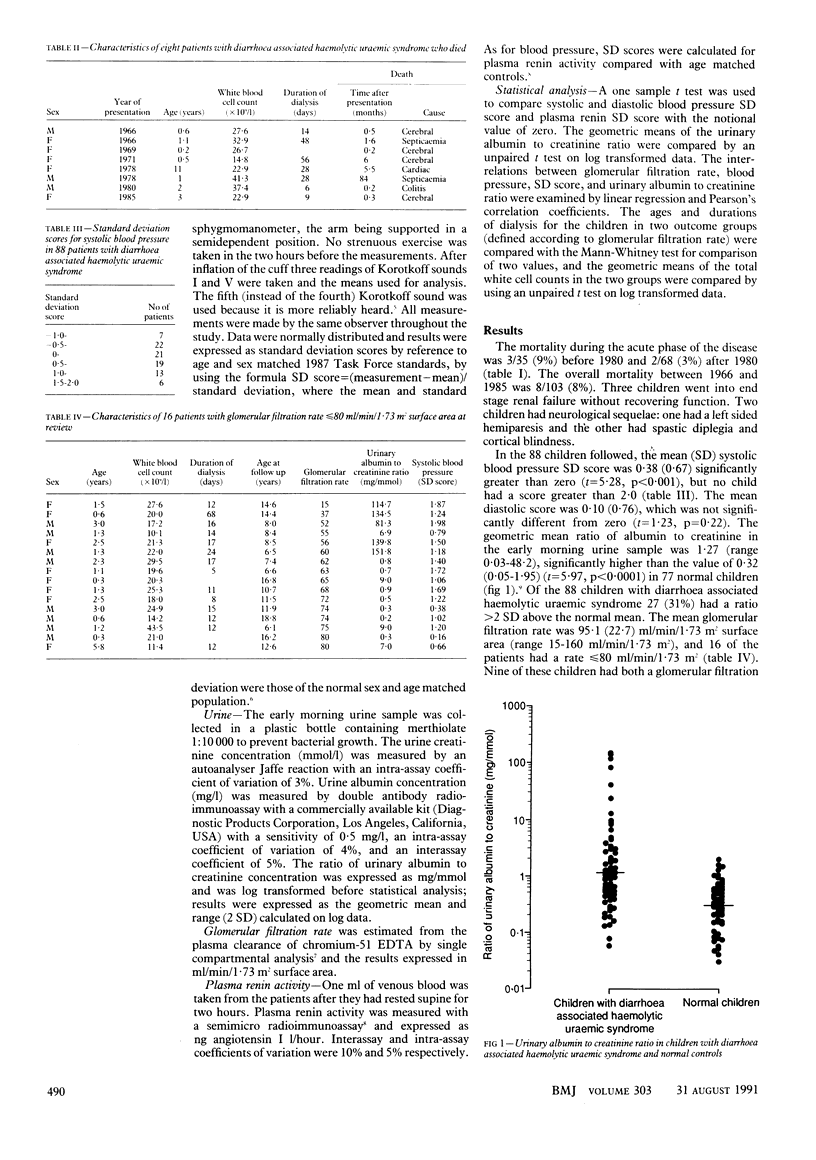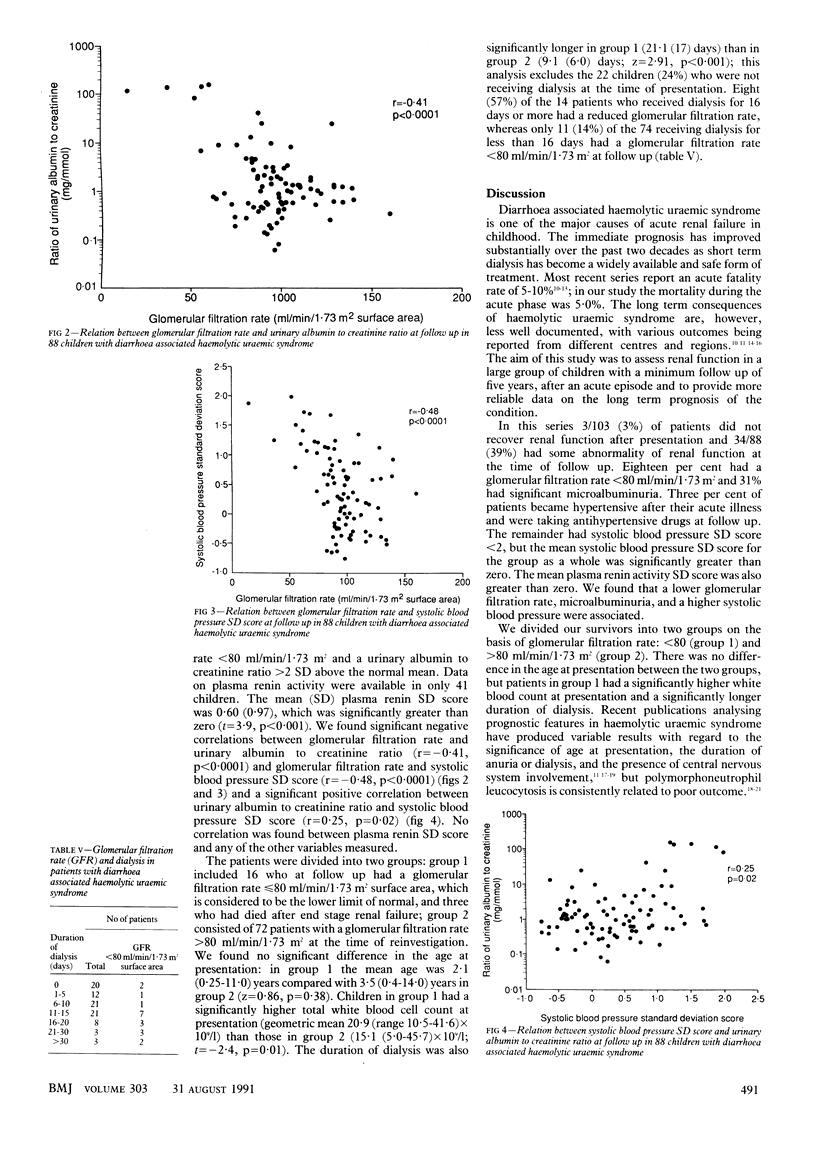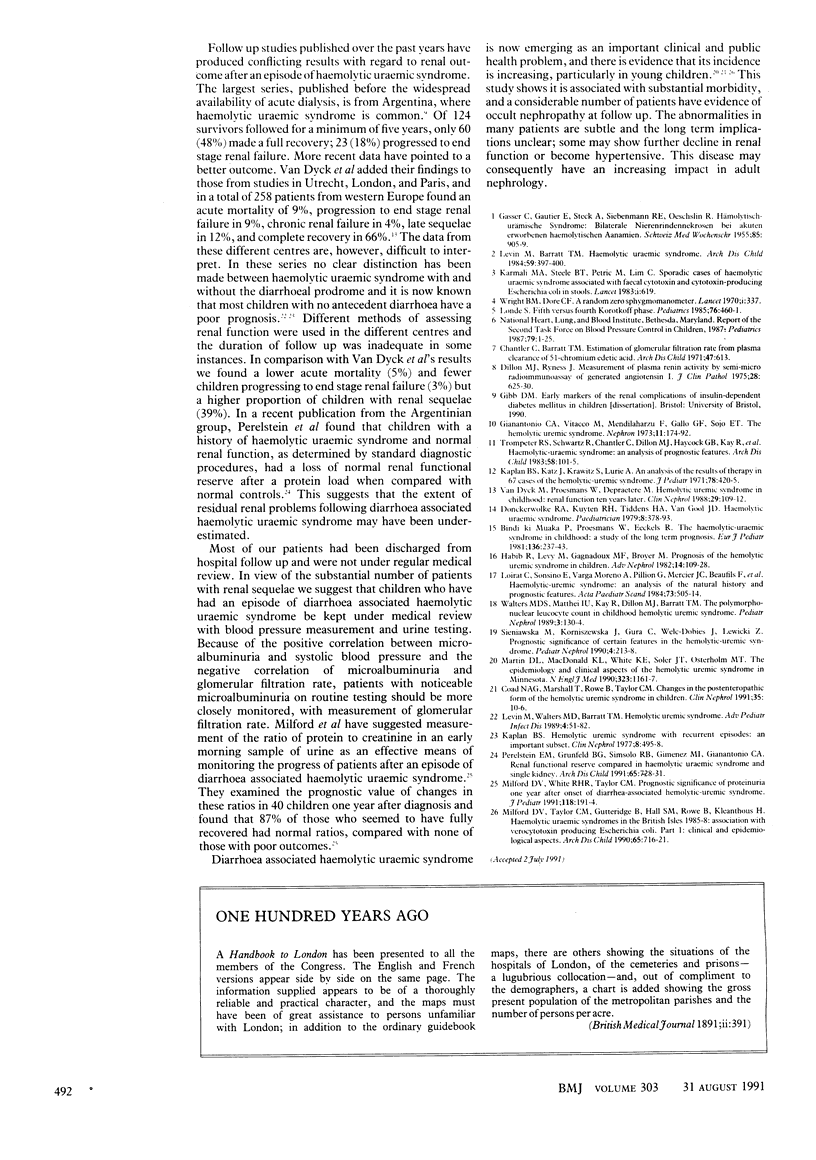Abstract
OBJECTIVE--To evaluate the long term outcome of renal function in infants and children after diarrhoea associated haemolytic uraemic syndrome. SETTING--The Hospital for Sick Children, Great Ormond Street, and the Royal Free Hospital, London. SUBJECTS--103 children with the syndrome who presented between 1966 and 1985; 88 attended for follow up investigations (40 male, 48 female) with a mean age 11.6 (range 5.2-22.6) years and a mean duration of follow up of 8.5 (range 5.1-21.3) years. MAIN OUTCOME MEASURES--Blood pressure, ratio of early morning urine albumin to creatinine concentration, glomerular filtration rate, and plasma renin activity. RESULTS--The mean (SD) systolic blood pressure standard deviation score was 0.38 (0.67) and diastolic blood pressure SD score was 0.10 (0.76). The geometric mean ratio of overnight urine albumin to creatinine concentration was 1.27 (range 0.03-48.2), significantly higher than the value observed in 77 normal children (0.32 (0.05-1.95), p less than 0.0001). Glomerular filtration rate estimated from the plasma clearance of chromium-51 EDTA was 95.1 (22.7) ml/min/1.73 m2 surface area, and 16 children had a rate of less than or equal to 80 ml/min/1.73 m2. Significant negative correlations were found between glomerular filtration rate and urinary albumin to creatinine ratio (r = -0.41, p less than 0.0001) and glomerular filtration rate and systolic blood pressure SD score (r = -0.48, p less than 0.0001). A significant positive correlation was found between urinary albumin to creatinine ratio and systolic blood pressure SD score (r = 0.25, p = 0.02). CONCLUSIONS--After an acute episode of diarrhoea associated haemolytic uraemic syndrome 31% (27/88) of children had an increased albumin excretion, 18% (16/88) had a reduced glomerular filtration rate and 10% (9/88) had both, in association with a higher systolic blood pressure, indicating considerable residual nephropathy in this group.
Full text
PDF



Selected References
These references are in PubMed. This may not be the complete list of references from this article.
- Binda ki Muaka P., Proesmans W., Eeckels R. The haemolytic uraemic syndrome in childhood: a study of the long-term prognosis. Eur J Pediatr. 1981 Jul;136(3):237–243. doi: 10.1007/BF00442990. [DOI] [PubMed] [Google Scholar]
- Chantler C., Barratt T. M. Estimation of glomerular filtration rate from plasma clearance of 51-chromium edetic acid. Arch Dis Child. 1972 Aug;47(254):613–617. doi: 10.1136/adc.47.254.613. [DOI] [PMC free article] [PubMed] [Google Scholar]
- Donckerwolcke R. A., Kuijten R. H., Tiddens H. A., van Gool J. D. Haemolytic uraemic syndrome. Paediatrician. 1979;8(5-6):378–393. [PubMed] [Google Scholar]
- GASSER C., GAUTIER E., STECK A., SIEBENMANN R. E., OECHSLIN R. Hämolytisch-urämische Syndrome: bilaterale Nierenrindennekrosen bei akuten erworbenen hämolytischen Anämien. Schweiz Med Wochenschr. 1955 Sep 20;85(38-39):905–909. [PubMed] [Google Scholar]
- Gianantonio C. A., Vitacco M., Mendilaharzu F., Gallo G. E., Sojo E. T. The hemolytic-uremic syndrome. Nephron. 1973;11(2):174–192. doi: 10.1159/000180229. [DOI] [PubMed] [Google Scholar]
- Kaplan B. S. Hemolytic uremic syndrome with recurrent episodes: an important subset. Clin Nephrol. 1977 Dec;8(6):495–498. [PubMed] [Google Scholar]
- Karmali M. A., Steele B. T., Petric M., Lim C. Sporadic cases of haemolytic-uraemic syndrome associated with faecal cytotoxin and cytotoxin-producing Escherichia coli in stools. Lancet. 1983 Mar 19;1(8325):619–620. doi: 10.1016/s0140-6736(83)91795-6. [DOI] [PubMed] [Google Scholar]
- Levin M., Barratt J. M. Haemolytic uraemic syndrome. Arch Dis Child. 1984 May;59(5):397–400. doi: 10.1136/adc.59.5.397. [DOI] [PMC free article] [PubMed] [Google Scholar]
- Levin M., Walters M. D., Barratt T. M. Hemolytic uremic syndrome. Adv Pediatr Infect Dis. 1989;4:51–81. [PubMed] [Google Scholar]
- Loirat C., Sonsino E., Varga Moreno A., Pillion G., Mercier J. C., Beaufils F., Mathieu H. Hemolytic-uremic syndrome: an analysis of the natural history and prognostic features. Acta Paediatr Scand. 1984 Jul;73(4):505–514. doi: 10.1111/j.1651-2227.1984.tb09962.x. [DOI] [PubMed] [Google Scholar]
- Londe S. Fifth versus fourth Korotkoff phase. Pediatrics. 1985 Sep;76(3):460–461. [PubMed] [Google Scholar]
- Martin D. L., MacDonald K. L., White K. E., Soler J. T., Osterholm M. T. The epidemiology and clinical aspects of the hemolytic uremic syndrome in Minnesota. N Engl J Med. 1990 Oct 25;323(17):1161–1167. doi: 10.1056/NEJM199010253231703. [DOI] [PubMed] [Google Scholar]
- Milford D. V., Taylor C. M., Guttridge B., Hall S. M., Rowe B., Kleanthous H. Haemolytic uraemic syndromes in the British Isles 1985-8: association with verocytotoxin producing Escherichia coli. Part 1: Clinical and epidemiological aspects. Arch Dis Child. 1990 Jul;65(7):716–721. doi: 10.1136/adc.65.7.716. [DOI] [PMC free article] [PubMed] [Google Scholar]
- Milford D. V., White R. H., Taylor C. M. Prognostic significance of proteinuria one year after onset of diarrhea-associated hemolytic-uremic syndrome. J Pediatr. 1991 Feb;118(2):191–194. doi: 10.1016/s0022-3476(05)80481-0. [DOI] [PubMed] [Google Scholar]
- Sieniawska M., Korniszewska J., Gura C., Welc-Dobies J., Lewicki Z. Prognostic significance of certain factors in the haemolytic-uraemic syndrome. Pediatr Nephrol. 1990 May;4(3):213–218. doi: 10.1007/BF00857656. [DOI] [PubMed] [Google Scholar]
- Trompeter R. S., Schwartz R., Chantler C., Dillon M. J., Haycock G. B., Kay R., Barratt T. M. Haemolytic-uraemic syndrome: an analysis of prognostic features. Arch Dis Child. 1983 Feb;58(2):101–105. doi: 10.1136/adc.58.2.101. [DOI] [PMC free article] [PubMed] [Google Scholar]
- Walters M. D., Matthei I. U., Kay R., Dillon M. J., Barratt T. M. The polymorphonuclear leucocyte count in childhood haemolytic uraemic syndrome. Pediatr Nephrol. 1989 Apr;3(2):130–134. doi: 10.1007/BF00852893. [DOI] [PubMed] [Google Scholar]


